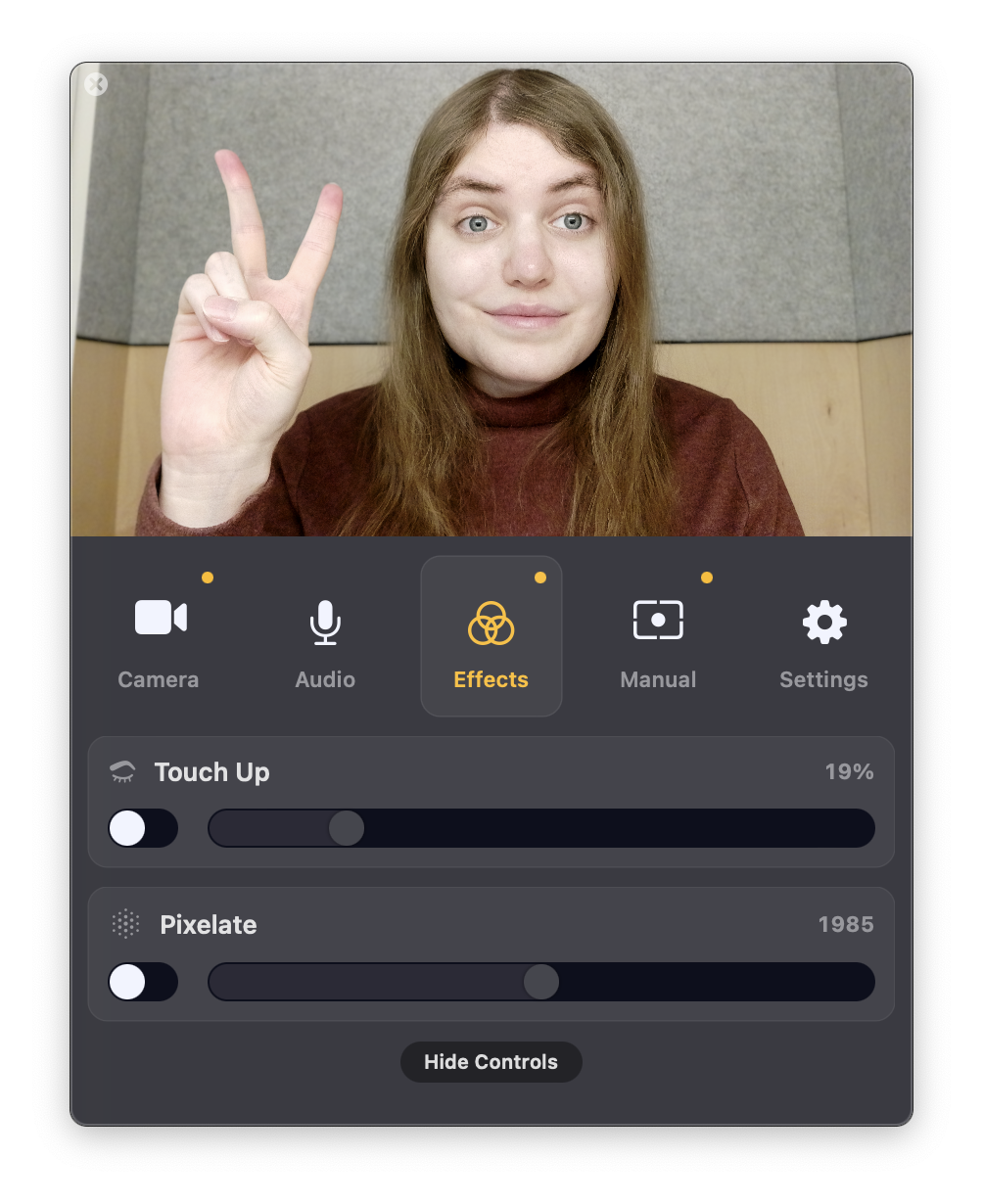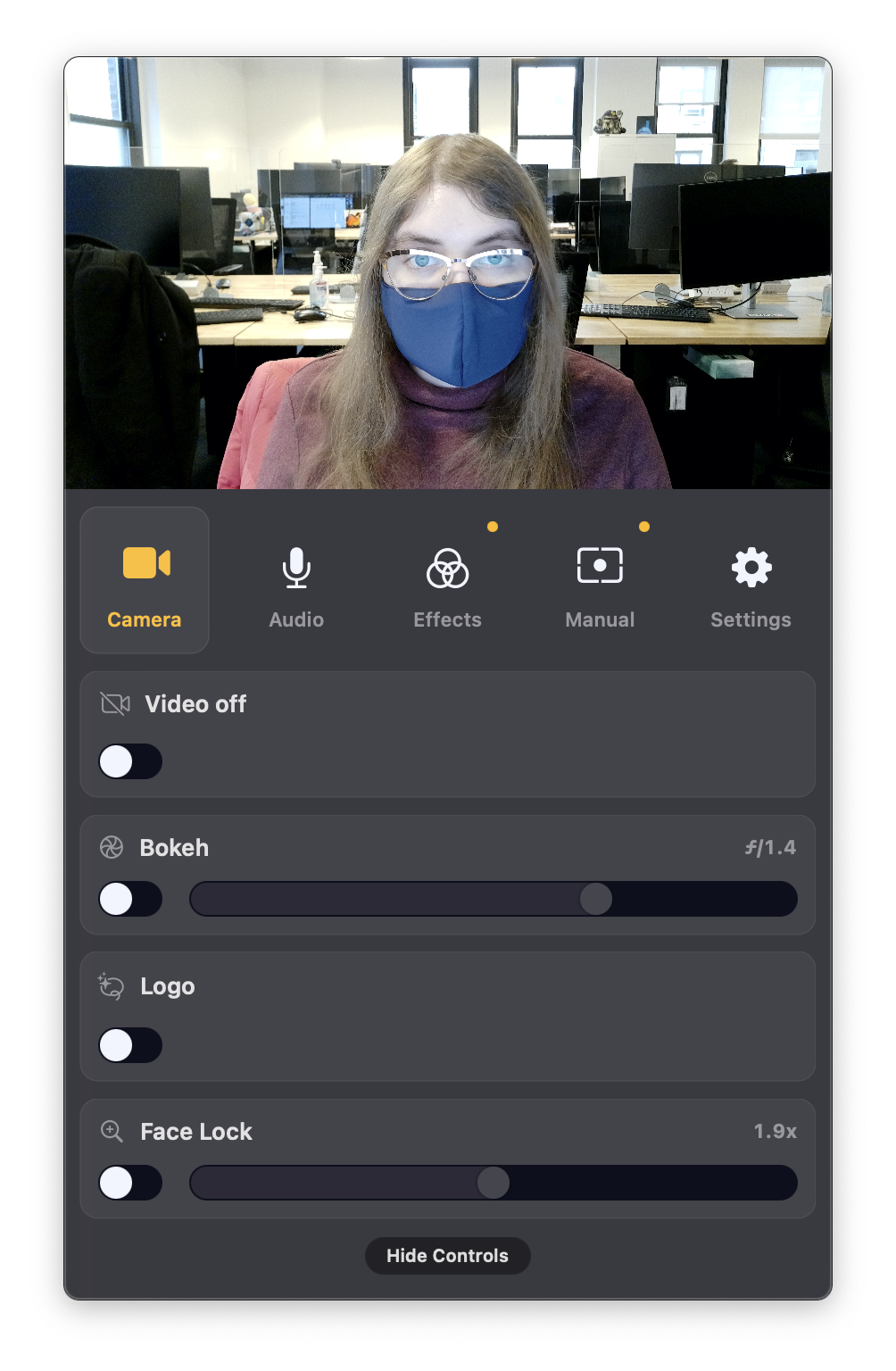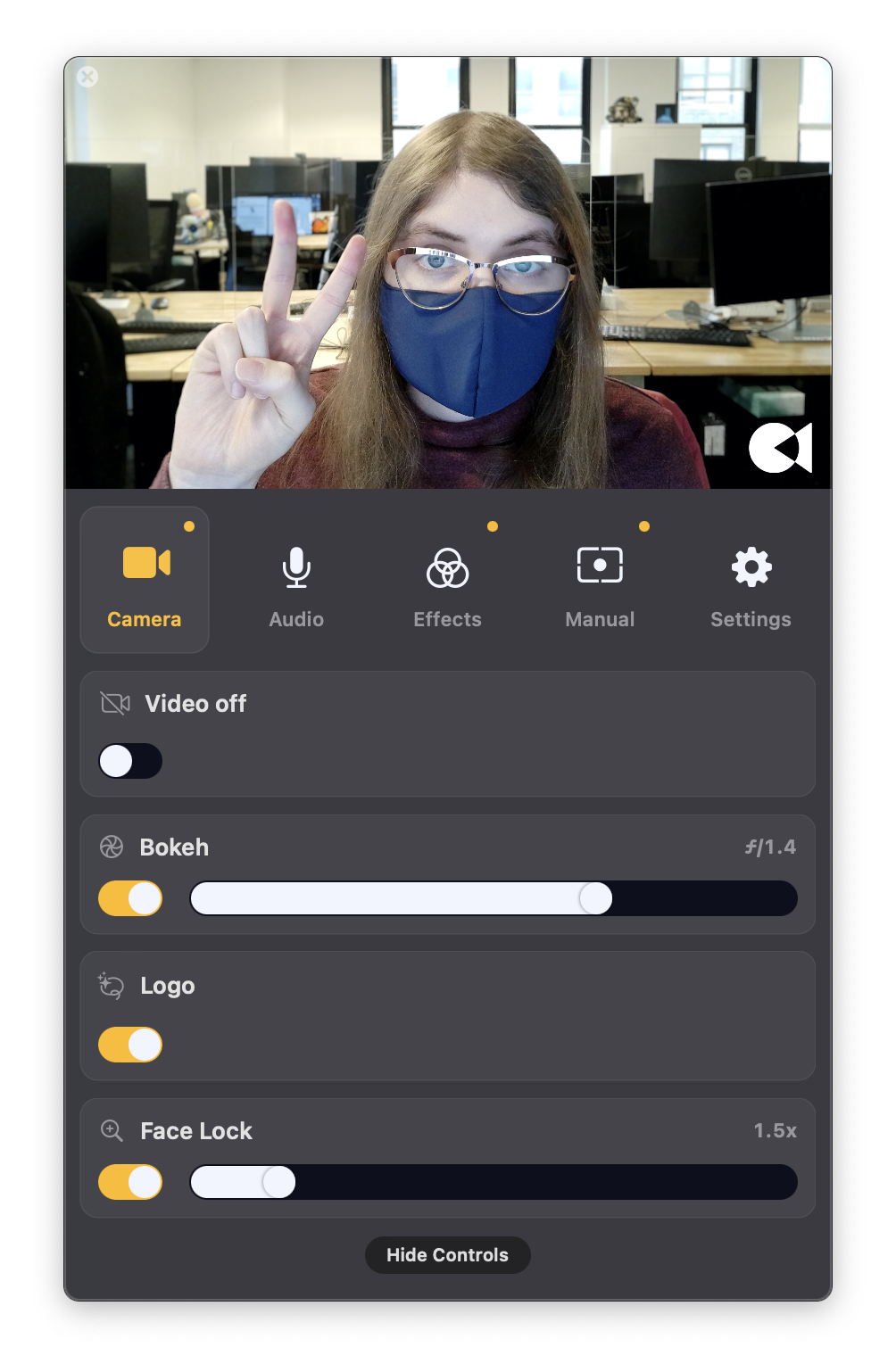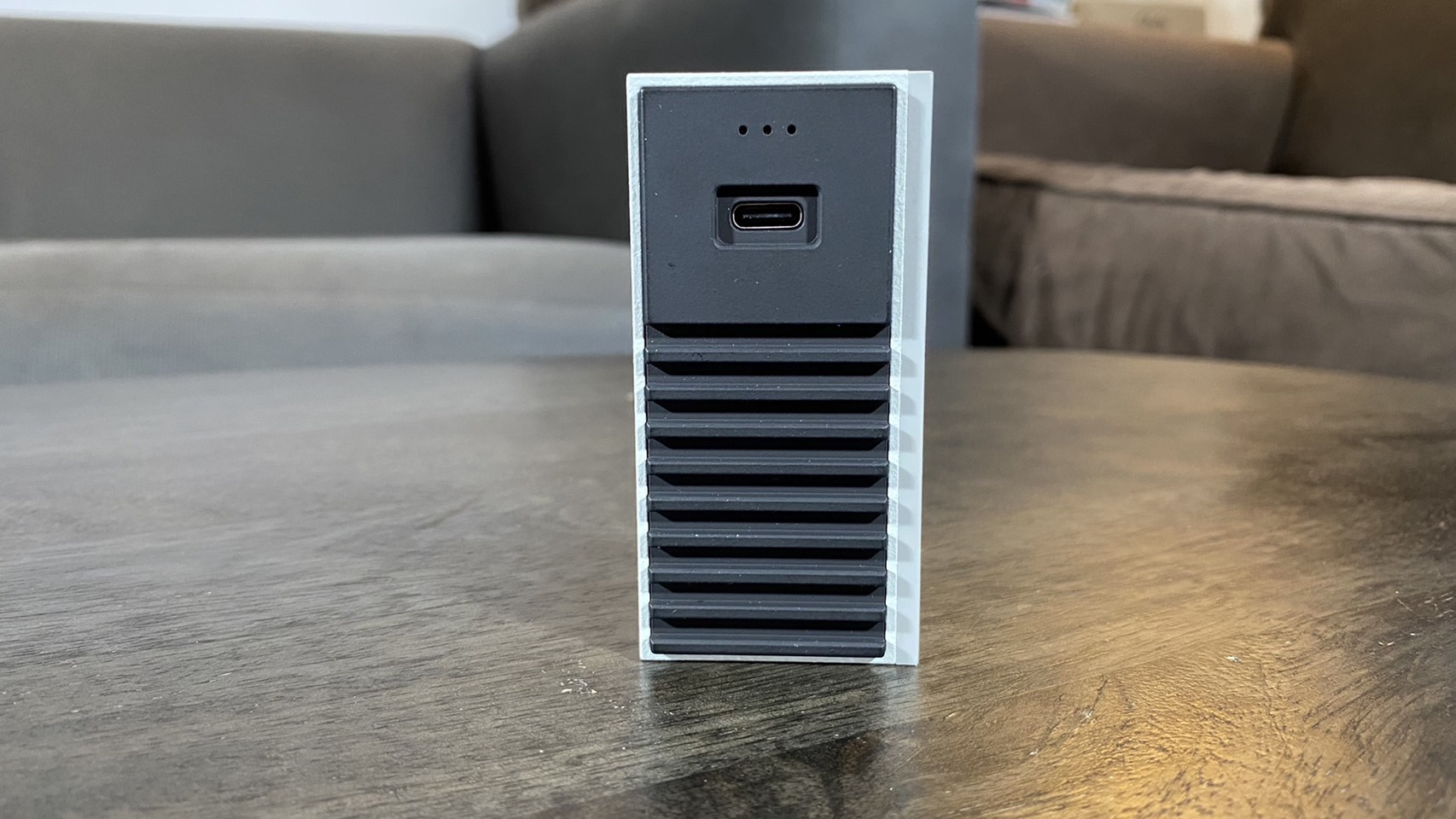Tom's Hardware Verdict
The Opal C1 largely produces the best-looking webcam footage I’ve ever seen, and while its price point and Mac-only ecosystem limit its audience, it represents an exciting future for webcams in general.
Pros
- +
+ Smartphone style computational photography
- +
+ Software is useful and easy to navigate
- +
+ MicMesh negates the need for a headset on casual calls
- +
+ Looks stylish
Cons
- -
Costs $300
- -
Software is Mac only
- -
Software requires a subscription
Why you can trust Tom's Hardware
Since they plug into a computer, even the best webcams don’t think to include a hefty processor of their own onboard. Not so with the Opal C1. Armed with the Intel Myriad X, a VPU specializing in on-device neural networks, the Opal C1 aims to help webcams catch up to the quality you might find on an iPhone or a Google Pixel.
The Opal C1 uses computational photography, a fairly common smartphone camera technique where the device combines developer tricks with details it’s learned about your face from past photos to touch up and adjust your video feed in real-time. This data doesn’t go into the cloud, so there are no privacy concerns (although there are ongoing debates about what it means to take photos or videos that “enhance” reality rather than reflect it), but that doesn’t mean the device doesn’t come without trade-offs.
Essentially, while it’s pretty hard to deny that the Opal C1 takes a great picture, it also costs $300. Of course, it’s targeted mainly at Mac users, coming with a robust software suite that doesn’t work on Windows. Sure, you can use the device on Windows, but it’s meant to work in tandem with its software. In other words, it’s intended to slot into the Apple ecosystem as a high-end lifestyle accessory for other high-end lifestyle products. There, it makes sense, but otherwise, it’s still not the DSLR replacement its advertising claims it to be. Video professionals will want to look elsewhere, while Windows users or casual video conferencers probably won’t need to shell out $300 for quality on this level.
At the same time, I shouldn’t undersell what having a smartphone-level camera experience on a webcam could mean for the future of the field. The Opal C1 sets a very exciting precedent.
Design of Opal C1
The Opal C1 unit I reviewed was technically still in beta, so while there were minor scuffs and black marks on my device, we shouldn’t expect those to be in the final version. However, what we should expect to see in the final version is the same textured, all-metal exterior, magnetic lens cover, miniature smartphone-style look, and heatsink on the back. That heatsink reminds us that this device is essentially a small computer, and its presence is necessary— the camera did get noticeably warm while I was testing.
You’ll notice that the Opal C1’s lens is off-center on the module’s body, and that’s because the right side of the device is dedicated to something called the “MicMesh.” This is an array of 3 omnidirectional beamforming microphones, and while you shouldn’t expect it to serve as a replacement for the best desktop microphones, these are the types of mics you find in the best gaming headsets.
Aside from the Opal C1’s main body, the device comes with a footless monitor mount that nonetheless gave me a sturdy connection to both curved and flat back monitors. The part of the mount that the camera screws into can also tilt 180 degrees downwards, although my unit needed a good amount of force to adjust it. Unfortunately, it can’t tilt upwards, although you can fake a swivel effect on the Opal C1 itself by adjusting the tightness of the screw that connects it to the mount. That screw-based connection also means you can mount the Opal C1 on a tripod if you prefer.
Get Tom's Hardware's best news and in-depth reviews, straight to your inbox.
The Opal C1 also has a single USB-C connection on the back, and the cable included with the device is USB-C to USB-C. I confirmed with one of the camera’s designers, Veeraj Chugh, that you can use a USB-C to USB-A cable with the device, but it must be USB 3.0. According to Chugh, the device comes with a C-to-C cable because it’s intended for use with current-generation MacBooks, which prioritize Type-C ports.
Speaking of MacBooks, the Opal C1 unit I reviewed has a white, black, and gray color scheme reminiscent of what you’ll find on Apple products. White is, of course, the primary color, with black and gray getting about equal levels of play across the device. If you prefer all-black devices, the device is also available with that color scheme.
Well-Lit Room


Because this is a $300 webcam, it wasn't easy to find many cameras in my collection that I could reasonably test against the Opal C1. I ultimately decided on the Dell Ultrasharp Webcam, a $200 webcam that's one of our favorites and one I have been using as a daily driver since June. It's less expensive but still costly enough to land in the premium range. Both cameras can also do 4K photos and 1080p @ 60 fps video.
Before I get into image quality, I should mention that the test photos I took for this review, except for those in the software section, were all captured using the standard Windows camera app. This usually wouldn't be worth mentioning, but the Opal C1 is intended for use with Macs and in tandem with its proprietary software. Still, it's essential to test it across both operating systems and with its out-of-the-box performance.
I should also mention that, while I took my Dell Ultrasharp photos at my desktop, I used a Windows laptop for the Opal C1. That's because the Opal C1 only has a USB-C to USB-C cable included with it, and my desktop currently can't accommodate that cable (yes, I'm looking into a new build). As such, the angles might be slightly different across shots.
Disclaimers aside, it's still pretty clear from the above photos that the Opal C1 boasts tremendous fidelity in what I would consider ideal light. I took these photos during mid-afternoon in my home office with most light sources activated. But even taking into account the slightly different angles of the shots I took, the Opal C1's photos show significantly fewer artifacts or distracting shadows. At the same time, the camera also makes my hair and skin look brighter without making them look uncanny.
Low Light Room


The Opal C1 and the Dell Ultrasharp Webcam performed more evenly in a lower light environment, where I closed my curtain and turned off all light sources aside from my screen. However, while the Opal C1 generally boasted higher quality, it compensated for the lower light by giving my hair and skin a somewhat upsetting pale, ghostly sheen. Photos taken in low light also have noticeable, dot-like artifacts throughout. Meanwhile, the Dell Ultrasharp photos have a smoother, less artifacted look, but conversely, they make my face look a little unnaturally warm and flushed.
Overexposed Room


When I saturated both the Opal C1 and the Dell Ultrasharp Webcam by pointing them at my window, the Opal C1 could not keep up. Although it portrayed the world outside my window with near-perfect accuracy, my face was covered in shadow, making it unusable under these conditions.
The Dell Ultrasharp Webcam, by contrast, put the focus on my face. While the world outside my window was blurred and the fidelity on my face was less than ideal, shots taken under these conditions were at least usable. If your desk is in front of a window, you could conceivably use the Dell Ultrasharp Webcam to take a call from it without too much issue.
Software on the Opal C1
Much of the Opal C1’s functionality is hidden behind its software suite, which includes features like bokeh (blurring the background— there’s more to it than that, but that’s what you’ll experience here), touch up and an Nvidia Broadcast-style camera lock that keeps you in the frame as you move. There’s a slider for each, so you can control the intensity of the effect, and they all work quite well, but there’s a catch.
The Opal C1 software only works with Mac, and requires a $4 per month subscription. The Opal C1 website does say that the software is “free for early customers,” although it’s unclear if it’s free for life. I’ve reached out to Opal for clarification and will update the review when I hear back.



Before I get into the UI and the specifics of using the different features, I want to briefly touch on the ideal light, low-light and overexposed photos I took using the software. Since the camera isn’t technically meant for Windows, I needed to rerun my typical tests on a Mac. What I experienced wasn’t too different, aside from software additions like Touch Up. However, the camera held up to high light levels much better on Mac, with its software, than on Windows. My face is fully visible in shots I took in front of a window, as is the world outside the window behind me. From the right angle, I even got a pleasant lens flare effect.


Bokeh is probably the least impressive effect the software offers. Using it in my company’s office, I couldn’t tell much of a difference between the effect being on and off. If you sit on the software and A/B test for a while, you’ll eventually notice the slight fuzzing of the background, but even with the slider pushed relatively high, it’s a subtle difference.


Face Lock is more impressive, as it’s pretty responsive and the slider makes it very configurable. You can easily control the zoom on your face through slider intensity, and the camera follows you around about as well as Nvidia Broadcast and other options do. It never came across as wobbly or distracting, but if it did, it’s reassuring to know I could adjust its intensity through the slider.
Also, if Opal’s lifestyle brand ambitions weren’t clear enough, you can turn on a watermark with its logo in the C1’s software suite as well. Thankfully, this is easy enough to ignore. Also easy to ignore is the cute but very aggressive pixel filter you can apply to your footage.
Easily the most impressive feature in the Opal C1 software suite is its touch-up option. This uses an on-device neural network to edit your footage in real-time to remove blemishes, wrinkles and the like. The effect isn’t too dissimilar to what you might find naturally baked into a smartphone like the Google Pixel or iPhone, although it can slightly blur photos and create a little bit of an unnatural halo effect at higher intensities. Here are a few photos with it off, at default settings (around 19%) and nearly maxed out.



You’ll notice that my skin looks clearer and more blemish-free the higher the intensity, although the photo at 88% does have an uncanny, almost airbrushed quality to it. This brings to mind concerns about photos that don’t accurately reflect reality, although you can always turn off the Touch Up feature. Bokeh is such a mild effect that it and Face Lock alone might not be worth the subscription fee if you plan to ignore Touch Up.
It’s worth pointing out that smart Touch Up features often don’t handle darker skin well. While my complexion is very light, I video chatted with another Opal C1 user who has darker skin, and Touch Up did not negatively affect his experience with the camera.
Videos on the Opal C1
As a webcam, the Opal C1 is, of course, best viewed in motion. While photos make for great A/B comparison shots, I’ve also recorded a demonstration video showing how the camera fares in motion. The result? I really wish I bothered with makeup for this video because the Opal C1 does not lose any fidelity in motion.
The footage looks crisp and clear, even in my somewhat shadowy shooting environment, and it’s easy to make out even minute details on my face (much to my chagrin). The ability to record in 1080p @ 60 fps also adds great versatility to the camera. However, the Mac-oriented ecosystem means this camera isn’t likely to attract gaming livestreamers, who would be the most likely to get use out of such a feature.
That said, I did record this video on a Windows machine and still walked away impressed, even if I was missing the Touch Up feature.
A test video also makes for a great demonstration of what Opal is calling this webcam’s “MicMesh.” In reality, it’s just an array of three omnidirectional beamforming microphones. The signal-to-noise ratio here is 59 dba, and the effect is something like what you might find on the best gaming headsets. While headsets usually come with one microphone as opposed to three, the reason the end result here is still similar is likely distance. On a gaming headset, that one microphone is usually placed next to your mouth, whereas the Opal C1 needs to capture audio from a few feet away.
It’s not a replacement for a dedicated desktop microphone, but if you’re planning to take casual calls, you won’t need to buy a separate microphone for use with the Opal C1. That’s a big plus over competitors like the Dell Ultrasharp Webcam, which doesn’t have any microphone, as well as over other webcams in general, which typically have microphones that aren’t worth using. That latter point is why I didn’t mind too much when Dell’s webcam nixed microphones, but the Opal C1 is starting to make that decision seem like poor futureproofing.
Also, if used in tandem with the Opal C1 software, the MicMesh features noise cancellation, which further improves the professional applications of this webcam.
Build Quality of the Opal C1
I covered most of the Opal C1’s physical qualities, from its sturdy metal exterior to the minor scuffs that are likely just a result of me using a beta unit, when talking about its design. Still, I want to briefly touch on the webcam’s somewhat stingy cord length. While the USB-C to USB-C cable included with the webcam is conveniently pre-coiled on one end, the overall cord only extended to about 58 inches when I pulled it taut. That’s not horrible but doesn’t touch the 78 inches I got on the Dell Ultrasharp Webcam. On the bright side, the cable is removable, so you can substitute your own.
Bottom Line
The Opal C1 webcam is undoubtedly a niche, expensive product, but it represents a bright new future for webcams. While many webcams are just pitched as sensors that you attach to a computer, the C1 is a device in its own right. That means it has a smartly-considered build, a robust and easy-to-use software suite, and most importantly, its own processor.
The result is something more akin to what you might find on a higher-end smartphone, which is encouraging to see. Despite being smaller than computers, smartphones have been boasting better cameras than laptops and desktops for far too long.
Much of what makes the Opal C1 look so good are the little calculations it performs to enhance your footage on the fly. Most of these end up improving the final result, but photos can sometimes veer into the uncanny, especially in unusual lighting conditions.
Using computational photography means that your footage might not fully reflect reality, which is why I’m hesitant to parrot the marketing claims that the C1 is like a DSLR, a type of camera that lives and dies on accuracy. Photographers and other video professionals will probably want something that produces a more neutral look. Still, the end result for more casual users means you’ll look “touched up” in calls, and if you don’t mind a bit of digital airbrushing, it is a relieving feeling to know that your camera is helping you not look like you just crawled out of bed when you log into your morning standup.
Ethics and usefulness of reflecting an “enhanced” reality that might not exist aside, that lack of appeal to video professionals does mean that the Opal C1 is a bit hard to recommend, given its $300 price point. It’s primarily intended for video calls, but unless you’re a CEO or in the middle of a particularly grueling job interview cycle, I don’t think most people on video calls will expect you to have quality on par with what you’ll find on the Opal C1.
In that case, you can probably get away with something less expensive. The Opal C1 is also meant mainly for Macs, limiting its appeal to game streamers, who would otherwise fill a happy niche between casual video callers and full-on film directors.
Still, Mac users often pride themselves on having sleek, expensive gadgets that feel like the best-of-the-best, even if there’s technically better but more complicated and expensive enthusiast gear (like DSLRs) out there. If that sounds like you, the Opal C1 would make a great get.
If you’re a bit more wallet-conscious or use Windows, go for the Dell Ultrasharp Webcam instead because it’s $100 cheaper and offers excellent 4K image quality without any platform limitations. The Opal C1 represents a reality where webcams have finally caught up to smartphones, and hopefully means we’ll see similar technology in less expensive products in the future.
Michelle Ehrhardt is an editor at Tom's Hardware. She's been following tech since her family got a Gateway running Windows 95, and is now on her third custom-built system. Her work has been published in publications like Paste, The Atlantic, and Kill Screen, just to name a few. She also holds a master's degree in game design from NYU.
-
Giroro "The Opal C1 software only works with Mac, and requires a $4 per month subscription. "Reply
So the (absurdly high) $300 upfront price tag is misleading, because this camera is really in the "infinite money forever" subscription service category. The upfront hardware cost could be free, but the cost to own would still be "unlimited".
I would never buy hardware that is dependent on a subscription. With the exception of the minimum hardware required to function in society, because we have no choice but to pay for phone/internet/transportation/utilities/etc.
The greedy silicon Valley snobs behind Opal can raise the subscription price whenever they want, cut you off entirely or ban you from hardware that you bought and own. Plus your hardware becomes instant e-waste when this wanky startup company goes under.
You have no right or power to use your own hardware. Its an unethical business model, that frankly should be made illegal. We all want "right to repair" but we haven't yet reclaimed our "right to use".
Plus, you can already use your real smartphone as your webcam for the cost of an app. Or even buy a <$300 phone and use it as a dedicated camera. -
kristoffe This is a very good review, and that device is a terrible investment/product. A logitech c920/930 etc variance mops the floor with it.Reply -
mrv_co Interesting concept, but the monthly fee for software alone is a deal-killer ($300 + $60/year in perpetuity... yeah, no no no). The price comparison to the Dell camera really needs to include the price of an external microphone comparable to what the C1 includes.Reply -
c4v3man Agreed that the review needs to touch on the Microphone functionality, ideally in a noisy environment. The test video audio in a quiet room itself was not that impressive, and sounded like there was some clipping in the audio at times. It would also be nice to know how well the software works to reduce feedback from the speakers on your computer as well. That being said, even if the microphone is incredible, the video quality seems... decent. That's not the term you want to use when describing a camera at the top end of the premium market's pricing, along with a subscription to software that seems half-baked and limited to MacOS only. I've been happy with my Logitech Brio 4k, which seems to have landed around the one thirty to one seventy price bracket, and would be "premium enough" for most users, along with providing a reliable Windows Hello face unlock device for quick unlock on windows devices.Reply -
ikjadoon Excellent review. Really glad to see $300 products given "$300 worth of scrutiny".Reply
I really don't understand why a few phone brands won't produce a cheap $150 webcam with an average-for-phones sensor, a decent lens, and some old Qualcomm DSP from two years ago. They already have massive volume discounts on seemingly everything, right? It must be much harder than I'm thinking, right? I know, low volume, weak clients, etc., but near everyone I've worked with remotely has often complained, "Geez, I look like a goblin. Stupid windows".
I guess the market is too tiny and the margins still too small. Seems prime for brands like Samsung, Xiaomi, LG, OnePlus, Sony, etc., that have a "lifestyle brand" anyways. -
gggplaya I'll stick with using a DSLR on a tripod with a Rode Mic and an Elgato Cam link, which turns your DSLR hdmi output into a webcam. Many new DSLR's now have a webcam mode via USB.Reply
The Bokeh on this Opal C1 is unnoticeable, whereas a DSLR with a prime lens is much sharper with creamy bokeh.







